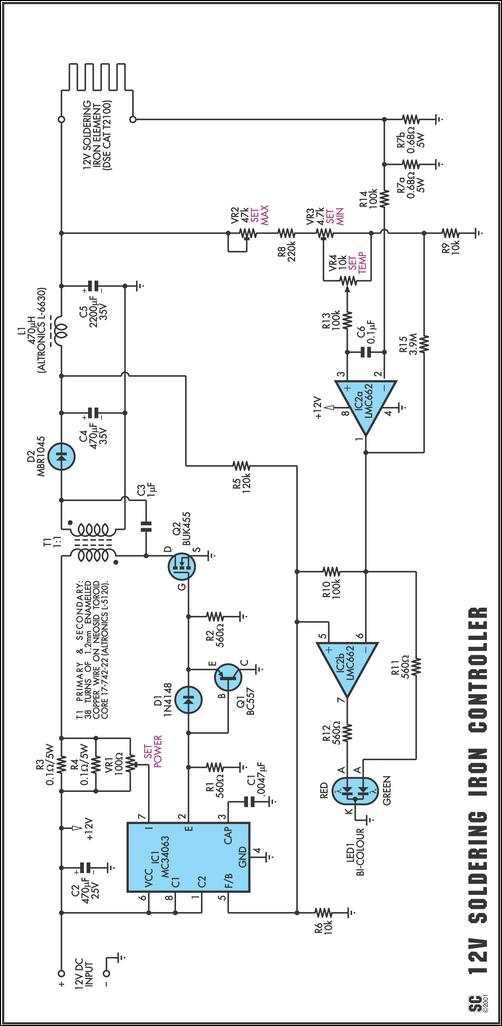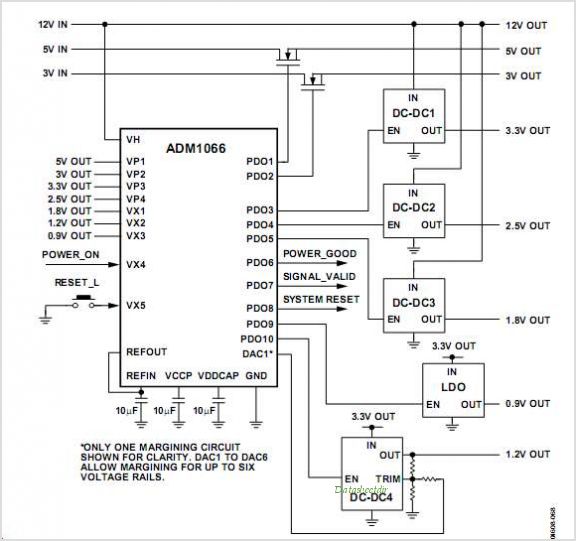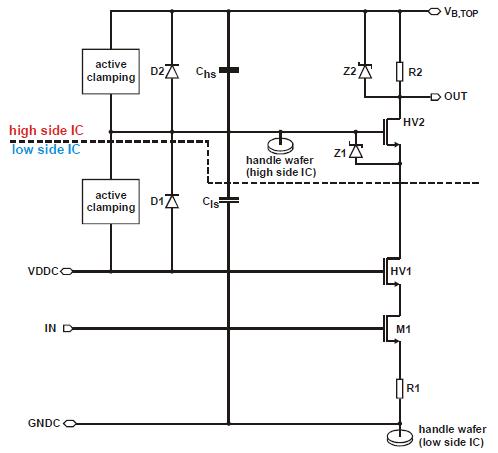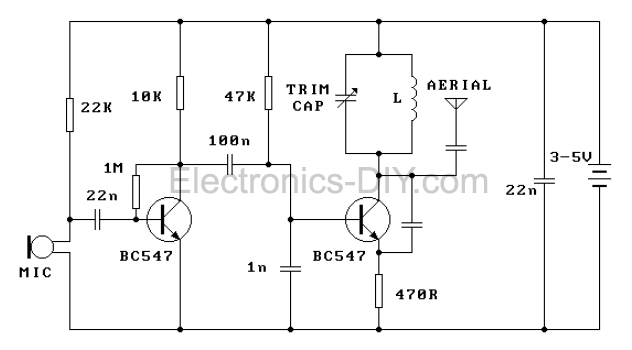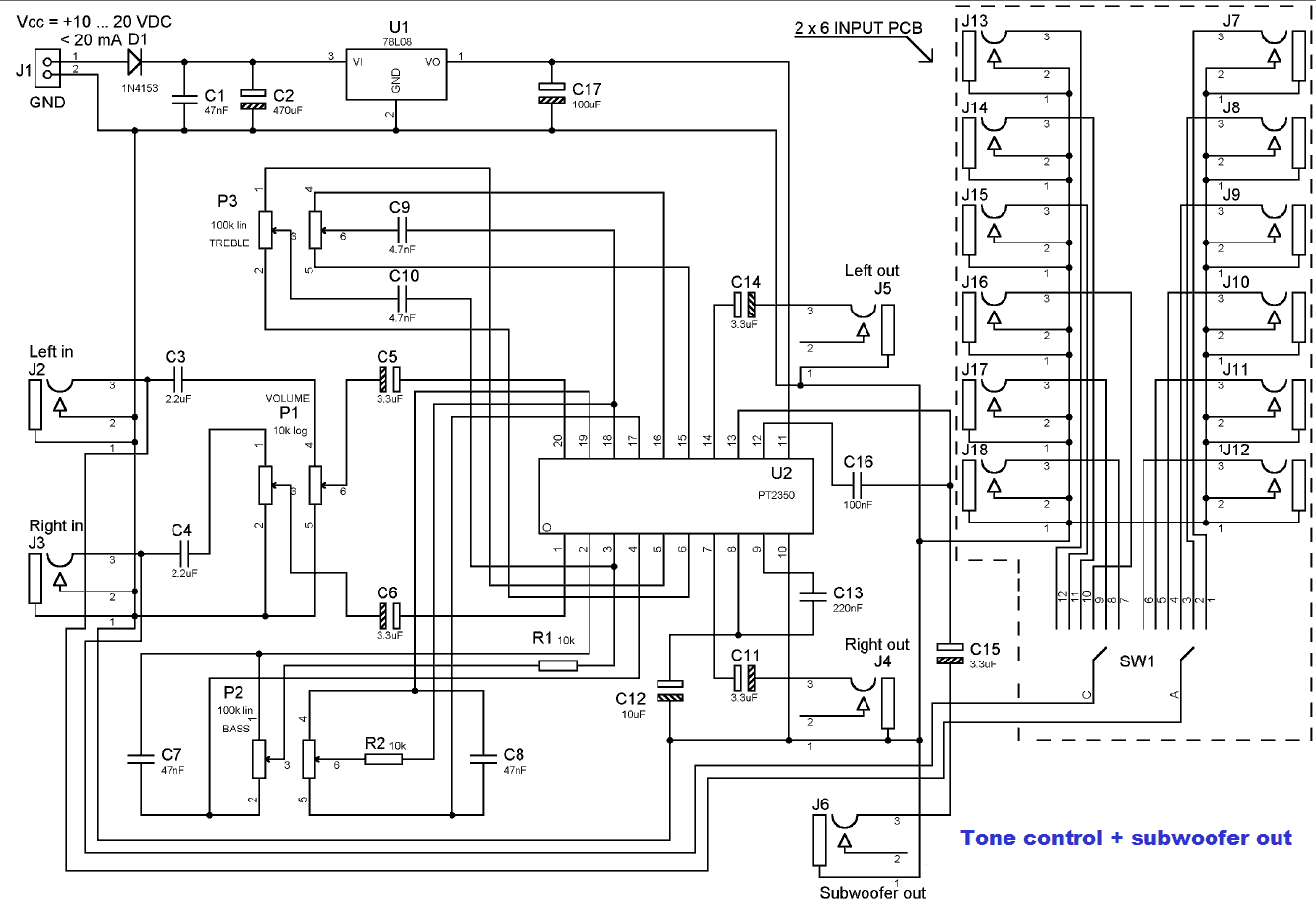
Upgrade your RC Transmitter with a DIY Tilt Motion Control Module

The RC transmitter utilizes a potentiometer for each axis, functioning as a voltage divider that outputs a voltage of 0.5V, with the middle position corresponding to 2.5V. This voltage is sent to the analog input, which is converted into a pulse of 1.2ms transmitted via RF. The module amplifies and shifts the accelerometer's analog output, typically 1.65V ± 0.4V, to match the range of the potentiometer before sending it to the transmitter. An operational amplifier (op-amp) is configured as an inverting amplifier, with Vref manually set to tune the output to 2.5V or the PWM pulse to 1.5ms. The theoretical value can be calculated based on feedback op-amp principles, where the voltage at the inverting and non-inverting terminals equalizes, making V(+) = V(-) = Vref. In practice, a trimmer resistor (R3) is adjusted until the output is 2.5V while the accelerometer is positioned horizontally, producing an output of 1.65V. The circuit can be built on a small proto-board, with part numbers indicated in the schematic. The connection to the transmitter is illustrated in accompanying images and the schematic. An accelerometer such as Acc_Gyro or a custom break-out board can be used. The module should be mounted in a free space beneath the antenna using double-sided foam tape to minimize vibration. Power for the module is supplied from the potentiometer contacts, providing +5V. A test with an LED can verify that the power contacts deliver at least 20mV, while the module consumes less than 5mA. A close-up of the module shows a custom accelerometer break-out board, though pre-assembled options are widely available. An analog accelerometer is required for this project.
The described RC transmitter circuit integrates a potentiometer for each axis, which serves as a voltage divider. The output voltage varies from 0.5V to 2.5V, where 2.5V represents the neutral position. This voltage is crucial as it is fed into the analog input of the transmitter, which converts it into a 1.2ms pulse for RF transmission. The module's role includes amplifying and shifting the output of the accelerometer, which typically ranges around 1.65V ± 0.4V, to align with the potentiometer's output range.
An operational amplifier, configured as an inverting amplifier, is the main component for this voltage adjustment. The reference voltage (Vref) is manually set to ensure proper output tuning. The theoretical calculations for the op-amp's behavior are grounded in feedback principles, where the voltages at the inverting and non-inverting terminals stabilize to equal the reference voltage. Practically, this is fine-tuned using a trimmer resistor (R3) while ensuring the accelerometer is in a horizontal position, yielding an output of 1.65V.
The construction of the circuit can be carried out on a proto-board, with all necessary components and their respective part numbers clearly indicated in the schematic provided. The connection details to the transmitter are further elucidated in the accompanying images, ensuring clarity in the assembly process.
For the accelerometer, options include using an Acc_Gyro module or creating a custom break-out board tailored to specific requirements. The physical installation of the module is critical; it should be mounted beneath the antenna using double-sided foam tape to mitigate the effects of vibration, thereby enhancing the accuracy of readings.
Powering the module is achieved through the potentiometer contacts, which supply +5V. A simple LED test can confirm that the power contacts can provide a minimum of 20mV, while the module itself operates with a low current draw of less than 5mA. The project may utilize a custom-built accelerometer break-out board, although numerous pre-assembled alternatives are available on the market. An analog accelerometer is essential for the successful implementation of this project, ensuring accurate data transmission and response.The RC transmitter uses a potentiometer for each axis, it acts as a voltage divider sending a voltage of 0. 5V (the middle position corresponds to 2. 5V) to the analog input that is converted into a pule of 1. 2ms that is sent over RF. This module converts (amplifies and shifts) the accelerometer analog output, usually 1. 65 +/- 0. 4V to the same rang e of the potentiometer and sends it to the transmitter instead. An op-amp in an inverting amplifier configuration is used. Vref is set manually by tuning the output to be 2. 5V (or the PWM pulse to be 1. 5 ms). However it is possible to calculate the theoretical value as follows: Note that according to the rules of a feedback op-amp the voltage on it`s inverting/non-inverting terminals tends to equalize so V(+) = V(-) and in our case = Vref. Well, this is the theoretical value, in practice we adjust the trimmer R3 until the output is 2. 5 while the accelerometer is in laying in horizontal position (has an output of 1. 65V). To build use a small proto-board following schematic. Part numbers are mentioned on schematic. Hook-up with the transmitter is described in images below and on the schematic. For accelerometer use Acc_Gyro or similar module, or build your own accelerometer break-out board. The module is mounted in a free space under antenna using double-sided foam tape best way to mount an accelerometer to avoid vibration.
Note that we get +5V power for the module from the potentiometer contacts. You can test with a led that the power contacts can deliver at least 20mV, the module uses far less <5mA. Here is a close-up of the module, as you can see I did my own accelerometer break-out board, but you can buy a pre-assembled one, there are many choices. You will need an analog accelerometer for this project. 🔗 External reference
The described RC transmitter circuit integrates a potentiometer for each axis, which serves as a voltage divider. The output voltage varies from 0.5V to 2.5V, where 2.5V represents the neutral position. This voltage is crucial as it is fed into the analog input of the transmitter, which converts it into a 1.2ms pulse for RF transmission. The module's role includes amplifying and shifting the output of the accelerometer, which typically ranges around 1.65V ± 0.4V, to align with the potentiometer's output range.
An operational amplifier, configured as an inverting amplifier, is the main component for this voltage adjustment. The reference voltage (Vref) is manually set to ensure proper output tuning. The theoretical calculations for the op-amp's behavior are grounded in feedback principles, where the voltages at the inverting and non-inverting terminals stabilize to equal the reference voltage. Practically, this is fine-tuned using a trimmer resistor (R3) while ensuring the accelerometer is in a horizontal position, yielding an output of 1.65V.
The construction of the circuit can be carried out on a proto-board, with all necessary components and their respective part numbers clearly indicated in the schematic provided. The connection details to the transmitter are further elucidated in the accompanying images, ensuring clarity in the assembly process.
For the accelerometer, options include using an Acc_Gyro module or creating a custom break-out board tailored to specific requirements. The physical installation of the module is critical; it should be mounted beneath the antenna using double-sided foam tape to mitigate the effects of vibration, thereby enhancing the accuracy of readings.
Powering the module is achieved through the potentiometer contacts, which supply +5V. A simple LED test can confirm that the power contacts can provide a minimum of 20mV, while the module itself operates with a low current draw of less than 5mA. The project may utilize a custom-built accelerometer break-out board, although numerous pre-assembled alternatives are available on the market. An analog accelerometer is essential for the successful implementation of this project, ensuring accurate data transmission and response.The RC transmitter uses a potentiometer for each axis, it acts as a voltage divider sending a voltage of 0. 5V (the middle position corresponds to 2. 5V) to the analog input that is converted into a pule of 1. 2ms that is sent over RF. This module converts (amplifies and shifts) the accelerometer analog output, usually 1. 65 +/- 0. 4V to the same rang e of the potentiometer and sends it to the transmitter instead. An op-amp in an inverting amplifier configuration is used. Vref is set manually by tuning the output to be 2. 5V (or the PWM pulse to be 1. 5 ms). However it is possible to calculate the theoretical value as follows: Note that according to the rules of a feedback op-amp the voltage on it`s inverting/non-inverting terminals tends to equalize so V(+) = V(-) and in our case = Vref. Well, this is the theoretical value, in practice we adjust the trimmer R3 until the output is 2. 5 while the accelerometer is in laying in horizontal position (has an output of 1. 65V). To build use a small proto-board following schematic. Part numbers are mentioned on schematic. Hook-up with the transmitter is described in images below and on the schematic. For accelerometer use Acc_Gyro or similar module, or build your own accelerometer break-out board. The module is mounted in a free space under antenna using double-sided foam tape best way to mount an accelerometer to avoid vibration.
Note that we get +5V power for the module from the potentiometer contacts. You can test with a led that the power contacts can deliver at least 20mV, the module uses far less <5mA. Here is a close-up of the module, as you can see I did my own accelerometer break-out board, but you can buy a pre-assembled one, there are many choices. You will need an analog accelerometer for this project. 🔗 External reference
